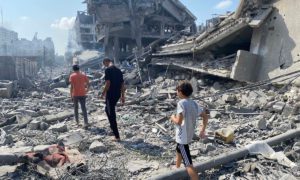“I was loading a truck with bricks when I heard a loud bang. And next I saw was a mountain of fire hovering above the sky, occasionally wobbling, until it spiraled down on the ground with a thud, so loud, that it hurt my ears. Then everything around me was awash with smoke,” recalls Wasim Akram, a truck driver, who witnessed the crash of an IAF plane, barely a hundred meters away, on the grounds of a brick kiln, in the village of Garaind, Budgam on Wednesday.
The plane crashed late in the morning, around 10:30 local time. A civilian and two pilots were killed, reportedly, in the crash. Two more are feared to be dead. This is the second IAF plane crash in three years in Budgam. Earlier the crash happened in Wadwan village, two kilometers away from Garaind village.
The time Wasim Akram was witnessing the ‘mountain of fire’ in the skies, Shahnawaz Ahmed, a resident of Garaind was sitting, with his friends, at the exact spot where the plane crashed. He, along with his friends, after seeing the plane on fire, ran away for their lives. Not everyone could run. Kifayat Hussain Ganie, a twenty-year old youth, was unable to run and came under the crashing plane, and died.

FPK Photo/Wasim Nabi
“When I saw the plane crashing down, I shouted: Run! Everyone started to run, but Kifayat froze, perhaps he had a heart attack. And next we heard was the loudest sound we have ever heard. And then all of a sudden we found ourselves in smoke, unable to think or see anything. Two boys peed in their pants,” recalls Shahnawaz, shaking with trauma, while he spoke.
Mehbooba Begum, a 40-year-old woman, was putting clothes on a rope to dry, when she heard a ‘loud sound in the skies’. She looked up and saw the plane coming down.
“I felt the ground skidding under my feet and my legs turned lifeless. I thought this is an atom bomb and the war between India and Pakistan has begun. Then I saw smoke rising up close to my house and I fell on the ground crying,” she says.

FPK Photo/Wasim Nabi
Momin Ahmed, 8-year-old boy of Garaind, ran away from his village after the crash to another village. Crying, he implored his mother to shift to some other village, saying, “I don’t want to live here. This is war. They will kill me… ”
After the plane crash, almost everyone in the village fled, fearing that the war has begun. And after half an hour, as the news began to spread, that it is just a plane crash, did they return. They headed straight to the crash site; to excavate the body of Kifayat Hussain.
The deceased was an orphan; his father has died three years ago. He was a daily wage laborer, a lone bread earner for his family, comprising of two sisters and mother; one sister is mentally challenged.
Close to the crash site lays the single-storey house of Kifayat. His mother and sisters and relatives were wailing, calling out the name of Kifayat. More and more people poured into the courtyard, arranging for his funeral, and waiting for his body which was taken by the police.
“They carried his body on a stretcher. It’s like a burnt wooden log — Czene Monger,” says Zainab Begum, a neighbor.

FPK Photo/Wasim Nabi
The village of Garaind is divided into two parts, Khrud Garaind and Kalan Garaind. It lies 5 km away from main town Budgam. A brick kiln, established in 2010 on the paddy fields, divides the village, geographically into two parts. The MiG 21 crashed in the brick kiln, missing the houses by around 20 meters.
“It was sheer luck that it didn’t fell in the village. There would’ve been a Karbala here now,” says Ali Mohammad, a local.
After the news spread, people ran through paddy fields towards the site. Around 50 armed forces vehicles were lined up on the road. The armed forces were scattered all over around the site. Hundreds of people had surrounded the site in a perfect circle, watching the debris burning and the armed forces trying to extinguish it with water.
The cops were trying to keep the people at bay from the site. After a while, the youth began to jeer at them and ended up in sloganeering.

FPK photo/Wasim Nabi
“They killed a boy. We are angry,” says Safdar, a youth. “Who is going to take care of his family now?”
Angry youth shortly engaged the armed forces with stone pelting. They threw clods of damp earth on the forces, who in-turn chased them, shooting an occasional tear gas shell to disperse the crowd.
Soon more forces came to the site. The jeering continued and again changed into sloganeering. Around a hundred police men were stationed to manage the youth in the paddy fields. Amid clashes, the armed forces were busy in excavating the bodies of dead pilots from the debris.
Not far from the crash site, women and young girls were sitting on the ground; many had tears in their eyes. “This is terrifying,” said an old woman. “I can’t believe that this happened in our village. I hope there is no war upon us.”
Like this story? Producing quality journalism costs. Make a Donation & help keep our work going.






